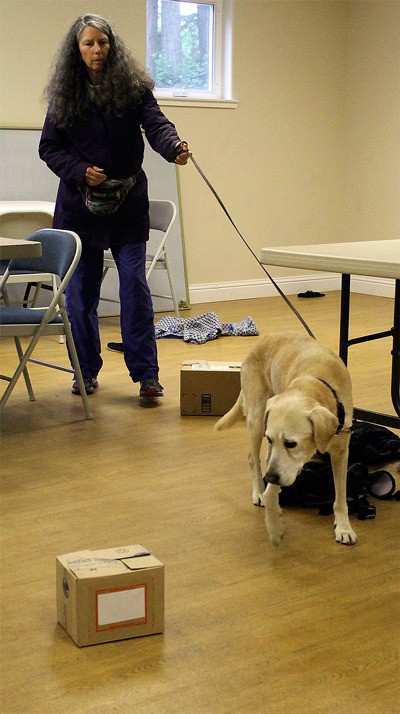Sniffing out a clue is elementary for Watson, a four-year-old wire-haired dachshund.
Watson and his human handler, Madeleine Pohl, are students in Georgia Edwards’ intermediate K9 Nosework class offered through the South Whidbey Parks and Recreation District. During the hour-and-a-half class period, dogs are encouraged to sniff out three “hides” which are stashed in locations throughout the room. Rather than actual animal skins, the “hides” are cotton swabs doused in essential oils anise, clove and birch.
Handlers pay close attention to their dog’s body language and breathing patterns in order to detect when the animal is hot on the trail.
Edwards said that one of the most difficult aspects of the sport for handlers is not pushing their dogs toward the hide location. Listening and patience are essential.
Due to the emphasis upon teamwork, dogs and their human companions typically become more attuned to one another through participation in the classes, Edwards said.
It is also an opportunity for dogs to remain active and to explore the full potential of their powerfully sensitive snouts.
K9 Nosework is the latest in competitive dog sports, according to Edwards. It has quickly garnered a great deal of participation due to its inclusiveness. Dogs with physical disabilities such as blindness, deafness or mobility impairments can participate, as can dogs who are shy or highly “reactive.”
Many K9 participants are former show dogs, or dogs whose desire to work is ostensibly genetic — breeds like hounds and dachshunds who have been bred to hunt.
“Virtually any dog can do nosework,” Edwards said.
Cody, a 16-year-old yellow lab mix, was formerly an American Kennel Club champion in agility. She’s lost most of her sight and hearing and her hips are causing her some trouble. But with the gentle guidance of her handler, Susan Thorsen, she’s still able to detect each of the scents with relative ease.

Freeland residents Barbara and John Schuster accompanied three of their dogs to class Wednesday afternoon.
John Schuster is a judge in the American Kennel Club Earthdog competition, and the couple has shown several of their dogs in a variety of other AKC competitions throughout the years.
The Schusters’ now-deceased dog was a former AKC champion in a number of events, Barbara Schuster said. But when he lost his vision, he was no longer eligible to participate. K9 Nosework was a “godsend,” John Schuster said, because it allowed the visually impaired dog to continue doing what he loved.
An experienced noseworking dog can also be highly beneficial to humans struggling with physical ailments, Edwards noted.
A retired oncologist, Edwards said she regularly brought her Bouvier des Flandres dogs in to her workplace for use as therapy dogs for cancer patients.
Beginning in 1995, Edwards also began exploring the potential for breast cancer detection dogs. The idea was first outlined by physicians Howell Williams and Andres Pembroke in 1989, and is being used today by foundations such as the InSitu Foundation.
One of her especially sensitive dogs was able to smell the breakdown of tumor cells in cancer patients, and would remain by the side of a specific patient whenever her cancer was progressing.
Each time the patient went into remission, Edwards said, the dog would pay her no mind. But when the cancer returned, so did he. The dog remained with the patient when she died, Edwards said, staying by her side for a few moments afterward before heading to the door as though he was ready to accept his next assignment.
Clinton resident Merrill Douglas said that her wire-haired dachshund, Daffodil, is able to detect when Douglas’ blood pressure is high.
The pair has been participating in Edwards’ classes for two years, beginning when Daffodil was nine months old. They took a three-year hiatus to chase after a few championships in other competitions, but have recently returned.
“It has made us a really good working team,” Douglas said.
When Douglas’ blood pressure is high, Daffodil hops up and gets in her face, she said, making it clear that something is not right.
Douglas said she’s not sure if it’s scent-related, but she is sure that the closeness they’ve developed through the class is what has lent Daffodil her intuitiveness.
Likewise, she’s able to take Daffodil on a loose lead “anywhere,” she said, due to the dog’s obedience and attentive nature.
“Langley is a really dog friendly city, so it’s really fun to be able to take my dog into any business and have them say, ‘Oh, let me hide the cookie and she’ll find it,’” said Douglas.
Douglas said she’s also been able to trust Daffodil to find other things, such as an old dog who wandered off.
K9 Nosework has been instrumental in exploring her dog’s full potential, she said.
“I’ve seen some really shy rescue dogs come out of their shell and be really happy,” Edwards said. “I’ve seen blind dogs… come out of the fear of being in the dark by using their nose.”
All breeds and backgrounds are welcome, Edwards said. Group classes cost $150 per dog for the session, which lasts five weeks. Classes are offered on Sundays and Wednesdays and are held at the South Whidbey Parks and Recreation Department Rec Center, room 125.
For more information and to register, visit swparks.org or caninenosework.com.


